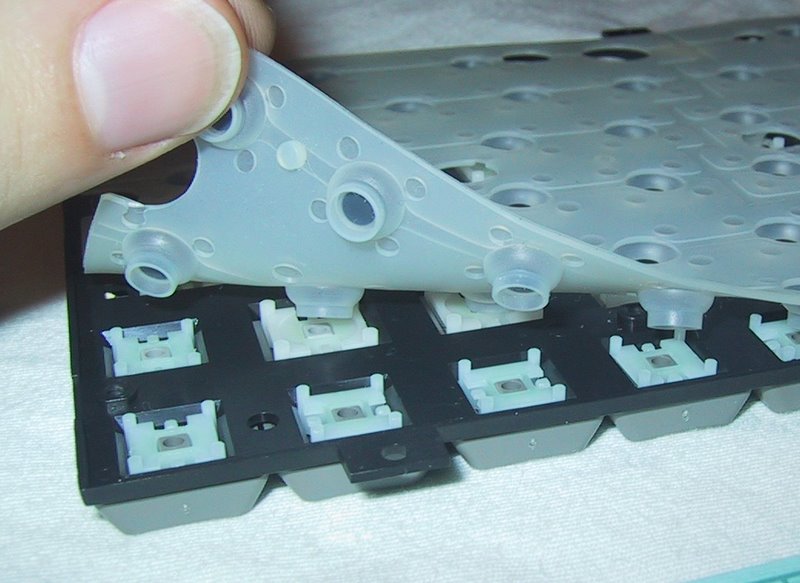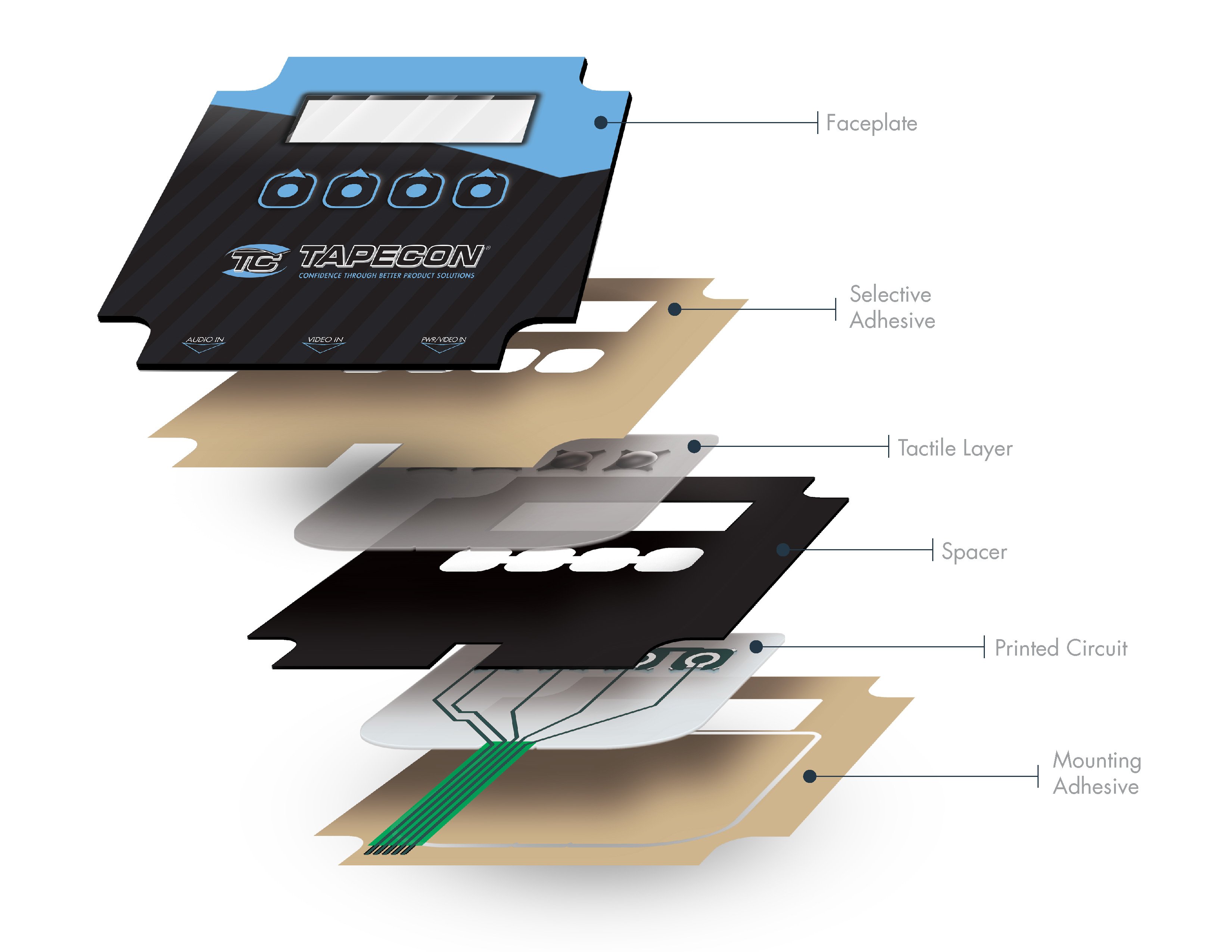Learn Why We’re a Trusted Membrane Switch Manufacturer
Learn Why We’re a Trusted Membrane Switch Manufacturer
Blog Article
Checking Out the Production Process of Membrane Switch for Numerous Industries
The manufacturing process of Membrane switches is a complicated endeavor that demands accuracy and interest to information. From selecting ideal materials to executing strenuous top quality control procedures, each step plays a vital function in ensuring performance. Different markets, including clinical and automobile, count on these elements for their special applications. Understanding the intricacies of this process exposes considerable understandings into exactly how these buttons are created and their impact throughout varied sectors.
Comprehending Membrane Switches Over: An Introduction

Secret Materials Utilized in Membrane Switch Manufacturing
In Membrane switch production, the option of key materials significantly influences capability and durability. Conductive products, adhesives, and coverings play vital roles, while substrate option impacts general efficiency and dependability. Recognizing these components is essential for maximizing the style and manufacturing of Membrane switches.
Conductive Products Summary
Conductive materials play an important role in the functionality of Membrane buttons, guaranteeing dependable electrical links within the device. Generally used materials include silver, copper, and carbon-based inks, each offering distinct advantages. Silver is favored for its high conductivity and longevity, making it suitable for applications requiring durable efficiency. Copper, while slightly less conductive than silver, is an economical option often made use of in printed circuits. Carbon-based inks provide a versatile alternative, suitable for applications where flexibility and lower prices are prioritized, although they have actually lower conductivity compared to steel alternatives. The option of conductive materials directly affects the general integrity, life expectancy, and performance of the Membrane switch, making it an important consideration in the manufacturing process.
Adhesives and Coatings
Adhesives and coverings are essential components in the manufacturing of Membrane switches, offering vital bonding and protective properties. These products assure that different layers of the button, consisting of graphic overlays and circuitry, adhere securely to each other, boosting longevity and capability. Generally made use of adhesives consist of pressure-sensitive adhesives (PSAs) and epoxy-based solutions, which offer solid bond and strength. Coatings, such as polyurethane or acrylic, offer to protect versus environmental elements, consisting of dampness, abrasion, and chemicals. Furthermore, coatings can enhance tactile comments and visual allure, adding to the total individual experience. The option of ideal adhesives and coatings is crucial for enhancing efficiency and longevity in diverse applications across various markets, ensuring that Membrane switches satisfy particular operational demands.
Substrate Choice Aspects
Substrate choice plays an important role in the manufacturing of Membrane buttons, as it considerably affects their general efficiency and longevity. Trick materials such as polyester, polycarbonate, and versatile printed motherboard (FPCBs) are typically used for their distinct buildings. Polyester is favored for its cost-effectiveness and resistance to abrasion, making it ideal for applications with high wear. Polycarbonate offers exceptional quality and effect resistance, perfect for atmospheres calling for high exposure. FPCBs offer improved versatility and are commonly utilized in intricate designs. The option of substratum additionally influences aspects like thermal stability, chemical resistance, and ease of printing. Inevitably, selecting the suitable substrate is important for ensuring the functionality and longevity of Membrane switches across numerous industries.
The Style Process of Membrane Switches Over
The style process of Membrane switches is a crucial phase that significantly affects the performance and appearances of the last product - membrane switch manufacturer. It begins with specifying the details needs of the application, including measurements, button layout, and tactile responses preferences. Developers should take into consideration user communication, guaranteeing that the switch is user-friendly and accessible.Next, materials are selected based on resilience, versatility, and ecological resistance. The combination of graphics and branding components is also important, as it boosts visual charm and interaction. Prototyping permits for repetitive screening, making it possible for modifications based upon user comments and performance evaluations.Additionally, the style needs to represent the electric elements, such as connectors and circuits, making sure integrity and simplicity of use. Eventually, a successful layout integrates functionality, aesthetics, and user experience, leading the method for reliable production and lasting performance in different industries
Printing Strategies for Membrane Switches Over
The printing strategies made use of in Membrane button manufacturing play a necessary function in determining the end product's high quality and performance. Display printing uses advantages such as sturdiness and dynamic shade application, while electronic printing innovations offer adaptability and precision in style. Understanding these methods can substantially influence the general performance of Membrane switches in different applications.
Display Printing Benefits
Various benefits make display printing a preferred method for producing Membrane switches. This method permits my explanation premium, lively colors and thorough layouts, which are essential for individual interface applications. Screen printing is particularly effective for using thick ink layers, enhancing resilience and responsive responses. In enhancement, it provides excellent attachment to various substratums, making sure long life sought after environments. The process is cost-effective for huge production runs, as it minimizes arrangement time and waste. Screen printing supports a wide range of inks, including specialized and UV-curable choices, making it possible for flexibility in layout. Its ability to create consistent outcomes across several systems makes it a trustworthy selection for manufacturers going for quality and effectiveness in Membrane switch production.
Digital Printing Innovations

Developments in electronic printing innovation are changing the manufacturing of Membrane switches, offering makers cutting-edge solutions that improve style versatility and effectiveness. Digital printing enables high-resolution graphics and complex styles, allowing custom branding and performance without the restrictions of traditional approaches. This method lowers arrangement times and costs, assisting in shorter production runs and minimal waste, making it excellent for companies with varying demands. Additionally, innovations in ink solutions offer much better toughness and attachment, guaranteeing durability in numerous settings. As industries progressively seek intricate and tailored styles, digital printing stands apart as a vital method, establishing a brand-new standard in Membrane button manufacturing. The integration of these technologies placements producers to fulfill evolving market requires efficiently.
Assembly and Layering of Membrane Switch Parts
Careful setting up and layering of Membrane button elements are important to assuring functionality and longevity. This process begins with the exact alignment of various layers, including the visuals overlay, sticky, circuit layer, and support product. Each component needs to be thoroughly positioned to keep electric stability and customer interface responsiveness.During assembly, conductive traces are related to the circuit layer, usually made from products like polyester or polycarbonate. This layer is crucial, as it beams when pressure is applied. The adhesive used for bonding these layers is additionally selected for its capacity to endure ecological tensions while keeping a protected bond.Heat and pressure are typically used throughout the setting up process to ascertain that the layers adhere effectively without jeopardizing the capability of the switch. Finally, interest is provided to the edge sealing to shield against dampness and contaminants, safeguarding the longevity of the Membrane switch in various commercial applications.
Quality Assurance Measures in Membrane Switch Production
Quality control procedures play a crucial duty in guaranteeing the reliability and performance of Membrane changes complying with the setting up and layering of their elements. In the production process, several crucial examinations are conducted to support high quality criteria. These include visual examinations for flaws in printing and adhesive application, in addition to functional tests to verify the responsiveness of each switch.Additionally, environmental testing is carried out to evaluate the buttons' toughness versus temperature changes and humidity exposure. Manufacturers usually apply analytical procedure control (copyright) techniques to monitor manufacturing consistency, enabling early detection of anomalies.Furthermore, traceability systems are developed to track products and elements, making certain accountability and helping with recalls if required. Calibration of devices and adherence to sector standards are also vital to keeping item integrity. Jointly, these quality assurance actions protect the performance of Membrane changes throughout numerous applications, official source inevitably boosting client complete satisfaction.
Applications of Membrane Switches Throughout Different Industries
Membrane buttons are utilized throughout a diverse variety of sectors, showcasing their versatility and adaptability. In the clinical field, they offer dependable and water-proof user interfaces for gadgets such as diagnostic devices and infusion pumps, making certain hygiene and convenience of use. The auto market utilizes Membrane switches for control panel controls, allowing smooth interaction between the motorist and car systems.In consumer electronic devices, these switches are found in devices and handheld devices, using a streamlined, modern visual while boosting capability. Industrial applications additionally utilize Membrane switches over for machinery control panels, where durability and resistance to harsh conditions are essential.Furthermore, the aerospace and defense markets use Membrane buttons for cockpit instrumentation and communication systems, focusing on integrity and performance under extreme conditions. Generally, Membrane buttons play an important function in improving the customer experience and functional effectiveness across various domain names.
Regularly Asked Inquiries
How much time Does It Take to Produce a Membrane Switch?
The manufacturing time for a membrane button commonly ranges from a couple of days to several weeks - membrane switch manufacturer. Factors affecting this period include style complexity, product schedule, and manufacturing quantity, all affecting the total timeline markedly
What Is the Regular Life Expectancy of a Membrane Switch?
The regular life expectancy of a membrane button generally varies from 1 article to 5 million actuations, depending on factors such as worldly top quality, environmental problems, and use regularity, considerably affecting sturdiness and overall performance.
Can Membrane Changes Be Personalized for Details Applications?
Membrane buttons can undoubtedly be personalized for details applications. Their design versatility enables for modifications in size, form, shades, and graphics, making sure compatibility with unique requirements throughout numerous markets and improving functionality and individual experience.

Are Membrane Switches Over Eco-friendly?
The ecological effect of Membrane switches over varies. Some products used might not be environment-friendly, while developments in making procedures are significantly concentrating on sustainability, aiming to reduce waste and advertise recyclable components in their production.
What Are the Typical Failing Settings of Membrane Switches?
Typical failing modes of Membrane switches consist of delamination, sticky failure, deterioration from use, moisture access, and electric failures. These concerns can significantly impact performance, performance, and life-span in numerous applications throughout various industries. Membrane buttons can be personalized to fit certain design demands, such as shape, size, and functionality, making them highly adaptable.The construction generally involves multiple layers, consisting of a graphic overlay, adhesive, and a circuit layer, which work together to produce a smooth individual experience. In Membrane button production, the choice of essential products substantially affects functionality and durability. The auto sector employs Membrane buttons for dashboard controls, allowing smooth communication between the driver and vehicle systems.In consumer electronic devices, these switches are found in home appliances and portable devices, using a streamlined, contemporary aesthetic while boosting capability. Industrial applications additionally leverage Membrane switches for equipment control panels, where resilience and resistance to harsh problems are essential.Furthermore, the aerospace and defense industries utilize Membrane buttons for cabin instrumentation and communication systems, focusing on reliability and performance under severe conditions. Membrane switches can without a doubt be customized for certain applications.
Report this page